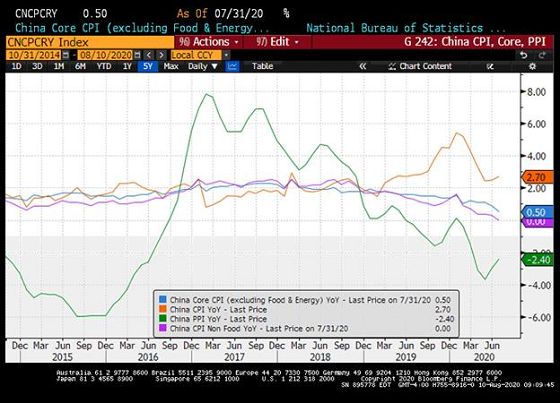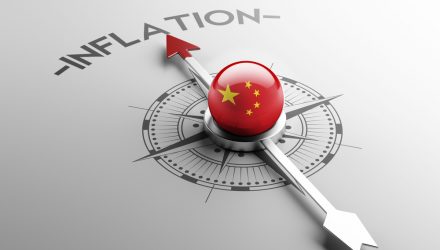By Natalia Gurushina, Chief Economist, Emerging Markets Fixed Income Strategy, VanEck Global
There are no signs of inflation pressures in China, which supports the accommodative policy stance. The market is skeptical that incremental measures will stop the currency rout in Turkey.
China continues to rebound from the COVID slump, but there are no signs of inflation. Yearly headline inflation rose to 2.7% in July, however, it was almost entirely driven by volatile food prices (flooding). Core inflation eased to 0.5% year-on-year and non-food inflation to 0% (see chart below), and a high base effect in food prices can exert additional downward pressure on headline inflation later this year. So, there are no reasons for the central bank to change its accommodative policy stance—with one caveat. Low inflation means higher real financing costs for smaller and privately-owned companies—and this is something that the current stimulus failed to address.
The Turkish currency continued to weaken this morning, as the market remains skeptical that incremental measures can stabilize the situation. Authorities changed the asset ratio for local banks in an attempt to slow the credit growth, and the central bank’s average cost of funding edged higher. The market, however, thinks in terms of a pre-emptive rate hike (à la Kazakhstan in March)—something that the central bank appears to be reluctant to do at this stage.
The post-election chaos in Belarus is drawing a lot of attention this morning—in part due to concerns that this can generate another proxy conflict in Europe. The official numbers point to the incumbent’s resounding victory (80% or so), but the opposition is not accepting the results. There are widespread riots (with dozens of wounded and detained), the internet is down and the military is deployed in the capital city of Minsk. Both sides question each other’s legitimacy, which limits the room for compromise.
Chart at a Glance: No Signs of Core Inflation Pressures in China

Source: Bloomberg LP
IMPORTANT DEFINITIONS & DISCLOSURES
PMI – Purchasing Managers’ Index: economic indicators derived from monthly surveys of private sector companies; ISM – Institute for Supply Management PMI: ISM releases an index based on more than 400 purchasing and supply managers surveys; both in the manufacturing and non-manufacturing industries; CPI – Consumer Price Index: an index of the variation in prices paid by typical consumers for retail goods and other items; PPI – Producer Price Index: a family of indexes that measures the average change in selling prices received by domestic producers of goods and services over time; PCE inflation – Personal Consumption Expenditures Price Index: one measure of U.S. inflation, tracking the change in prices of goods and services purchased by consumers throughout the economy; MSCI – Morgan Stanley Capital International: an American provider of equity, fixed income, hedge fund stock market indexes, and equity portfolio analysis tools; VIX – CBOE Volatility Index: an index created by the Chicago Board Options Exchange (CBOE), which shows the market’s expectation of 30-day volatility. It is constructed using the implied volatilities on S&P 500 index options.; GBI-EM – JP Morgan’s Government Bond Index – Emerging Markets: comprehensive emerging market debt benchmarks that track local currency bonds issued by Emerging market governments.; EMBI – JP Morgan’s Emerging Market Bond Index: JP Morgan’s index of dollar-denominated sovereign bonds issued by a selection of emerging market countries; EMBIG – JP Morgan’s Emerging Market Bond Index Global: tracks total returns for traded external debt instruments in emerging markets.
The information presented does not involve the rendering of personalized investment, financial, legal, or tax advice. This is not an offer to buy or sell, or a solicitation of any offer to buy or sell any of the securities mentioned herein. Certain statements contained herein may constitute projections, forecasts and other forward looking statements, which do not reflect actual results. Certain information may be provided by third-party sources and, although believed to be reliable, it has not been independently verified and its accuracy or completeness cannot be guaranteed. Any opinions, projections, forecasts, and forward-looking statements presented herein are valid as the date of this communication and are subject to change.
Investing in international markets carries risks such as currency fluctuation, regulatory risks, economic and political instability. Emerging markets involve heightened risks related to the same factors as well as increased volatility, lower trading volume, and less liquidity. Emerging markets can have greater custodial and operational risks, and less developed legal and accounting systems than developed markets.
All investing is subject to risk, including the possible loss of the money you invest. As with any investment strategy, there is no guarantee that investment objectives will be met and investors may lose money. Diversification does not ensure a profit or protect against a loss in a declining market. Past performance is no guarantee of future performance.







